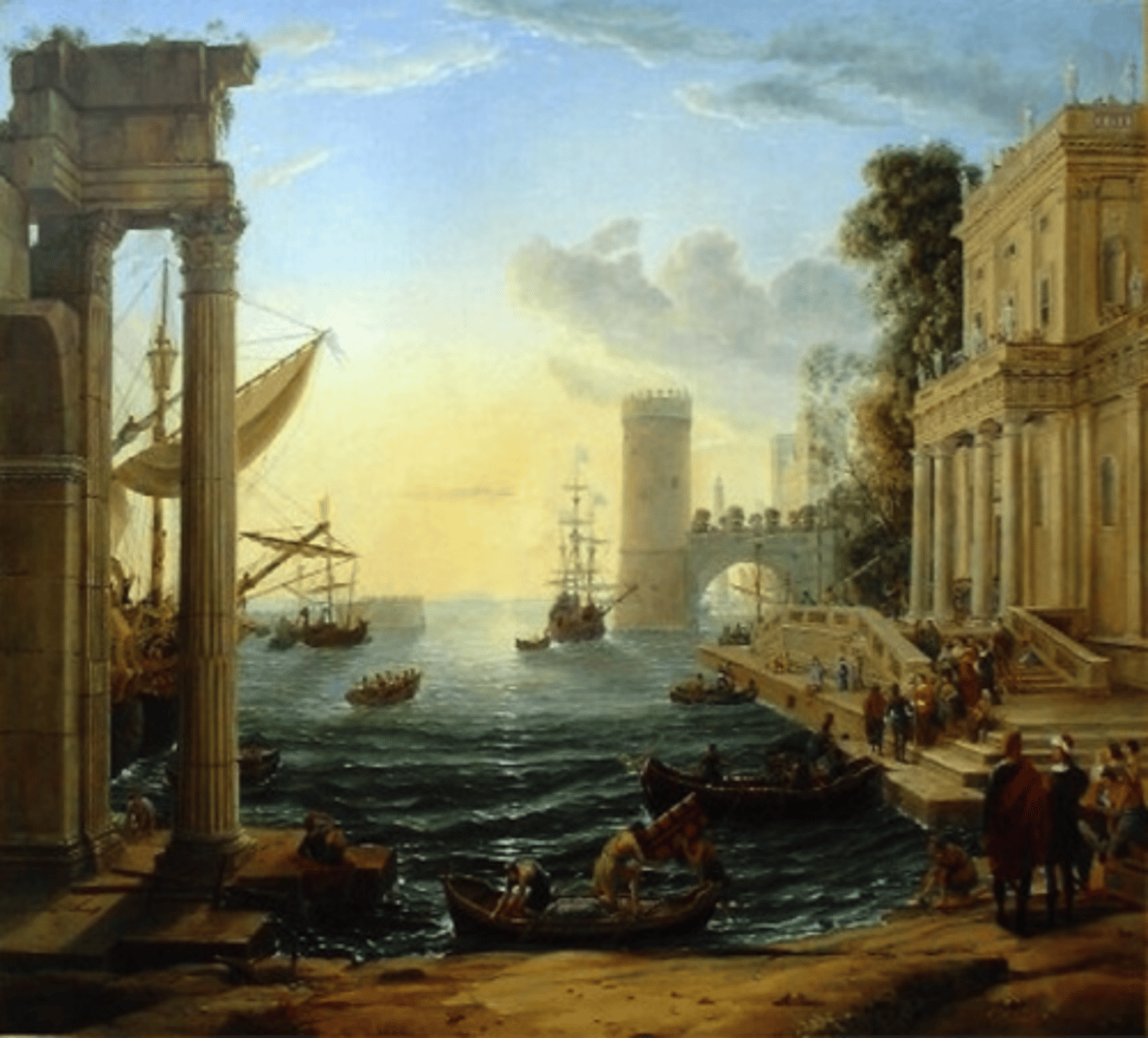ARTH 206 baroque art study guide
1/35
There's no tags or description
Looks like no tags are added yet.
Name | Mastery | Learn | Test | Matching | Spaced |
|---|
No study sessions yet.
36 Terms
Study and learn the characteristics associated with Baroque art. What are they?
-new way in which light is used in art is an important feature of the period, "The new understanding of the relationship of Earth and the Sun reaffirmed the expressive power of light, not as in the Middle Ages, but as a natural phenomenon to be treated with realism and drama."
-dramatic movement
-strong contrasts of light and dark
-perquisite heightened and active emotional involvement on the part of the viewer
-fascination with dramatization of space
-new concept of time (as a part of nature opposed to ecclesiastical time)
The role of the spectator changed in the Baroque period. As one feature of this change, the very space surrounding painting, sculpture and architecture became psychologically charged, engaged the viewer in a new way. Explain.
-viewers participated in works of art like audiences in a theater as the work of art drew them visually and emotionally into its orbit
-Treated viewers as participants in the artwork, and the space of the work included the world beyond the frame
Considering the role of the viewer, in what general way are some subjects in Catholic and Protestant countries alike?
-In both countries, the viewers felt an attachment with the art and inspired them to a reinvigorated faith by making them feel what was going on and inspiring pride in civic accomplishment.
-concentrated on genre paintings
-Compositions tended to have more open space -Objects and scenes were in a state of motion to create emotion; they either came out at the viewer or something could fall on the viewer
-The motion in these pieces was created through circular or diagonal compositions
Compare Michelangelo's David with the David by Bernini. One should very readily perceive what remarkable new direction Baroque artists have taken in their work. David is an example of a new type of composition. Explain
Michealagelos- David is a positive contemplating the task ahead. Shown naked, still/standing
Bernini's David- shown clothed, in the moment of action, shows real muscular definition, passion and fury in his face, engages viewers. David is in a state of motion, a diagonal composition, evoking emotion. He is more mature, with his lean body and tightly clenched mouth. Creating a twisting figure in movement incorporates the surrounding space within the composition, and the viewer becomes apart of the action rather than simply a detached viewer
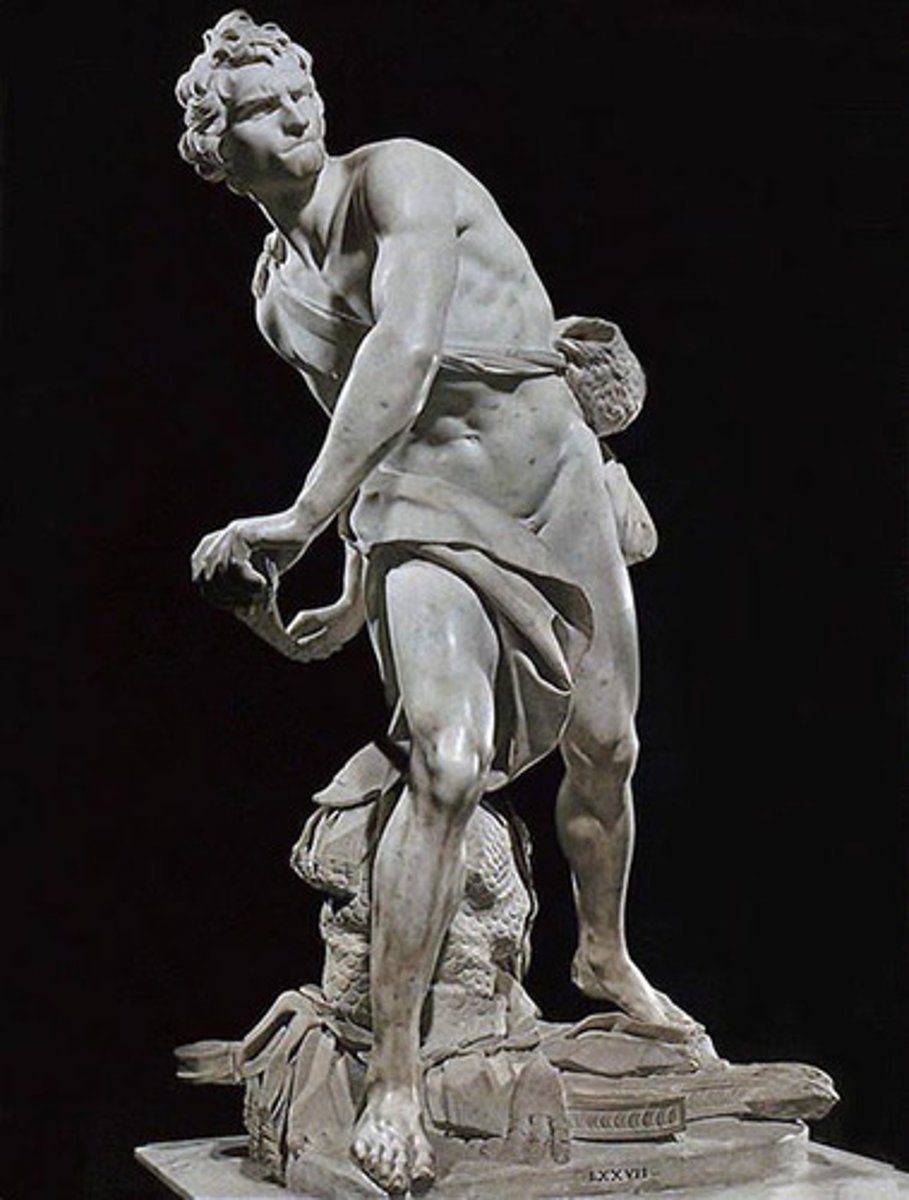
What is the source for the iconography of Gianlorenzo Bernini's Saint Teresa of Ávila in Ecstasy?
a vision described by the Spanish mystic in which an angel pierced St. Teresa of Avila's body repeatedly with an arrow, transporting her to a state of religious ecstasy, a sense of oneness with God
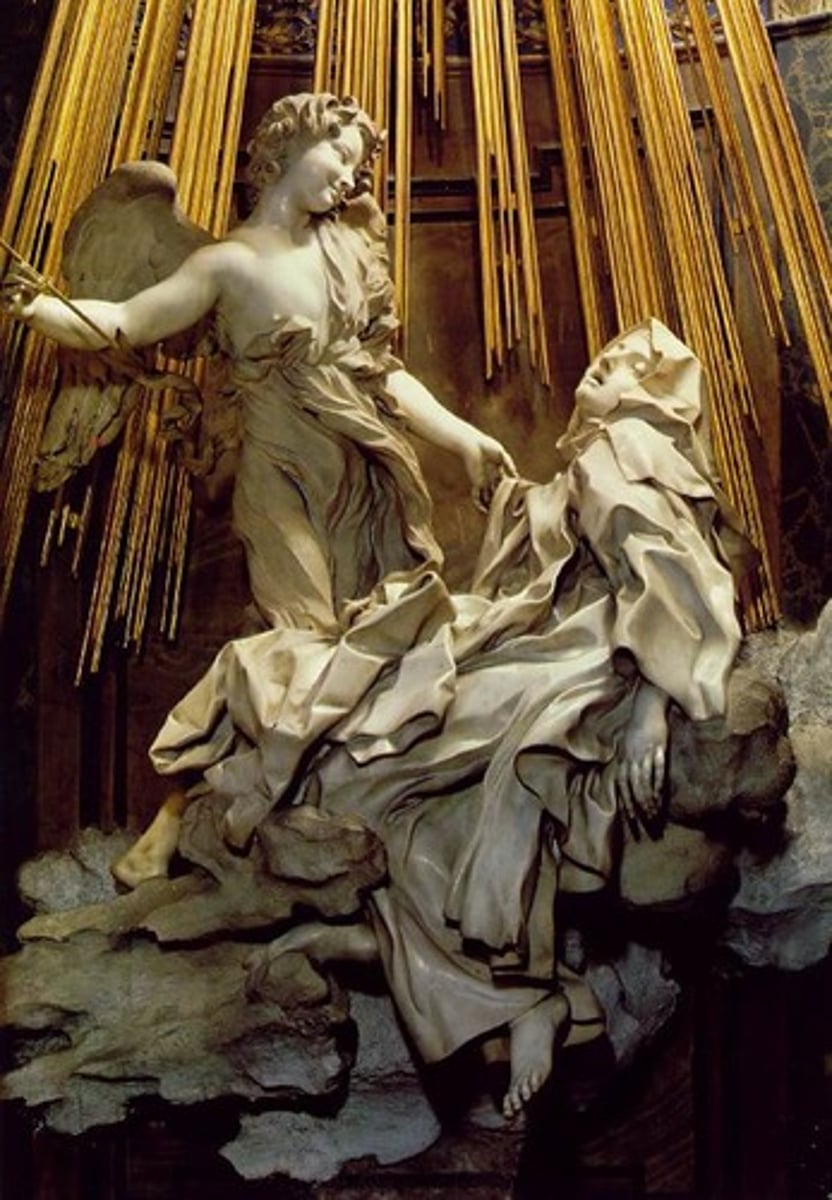
What characteristics of the Baroque are to be seen in Saint Teresa of Ávila in Ectasy?
-emotional and moving, with a diagonal composition
-angel seem to float upward on clouds
-emotions of these figures match by his virtuosity in simulating different textures and colors in the pure white medium of marble: the angel gauzy, clinging drapery deems silky in contrast with Theresa's heavy woolen monastic robe
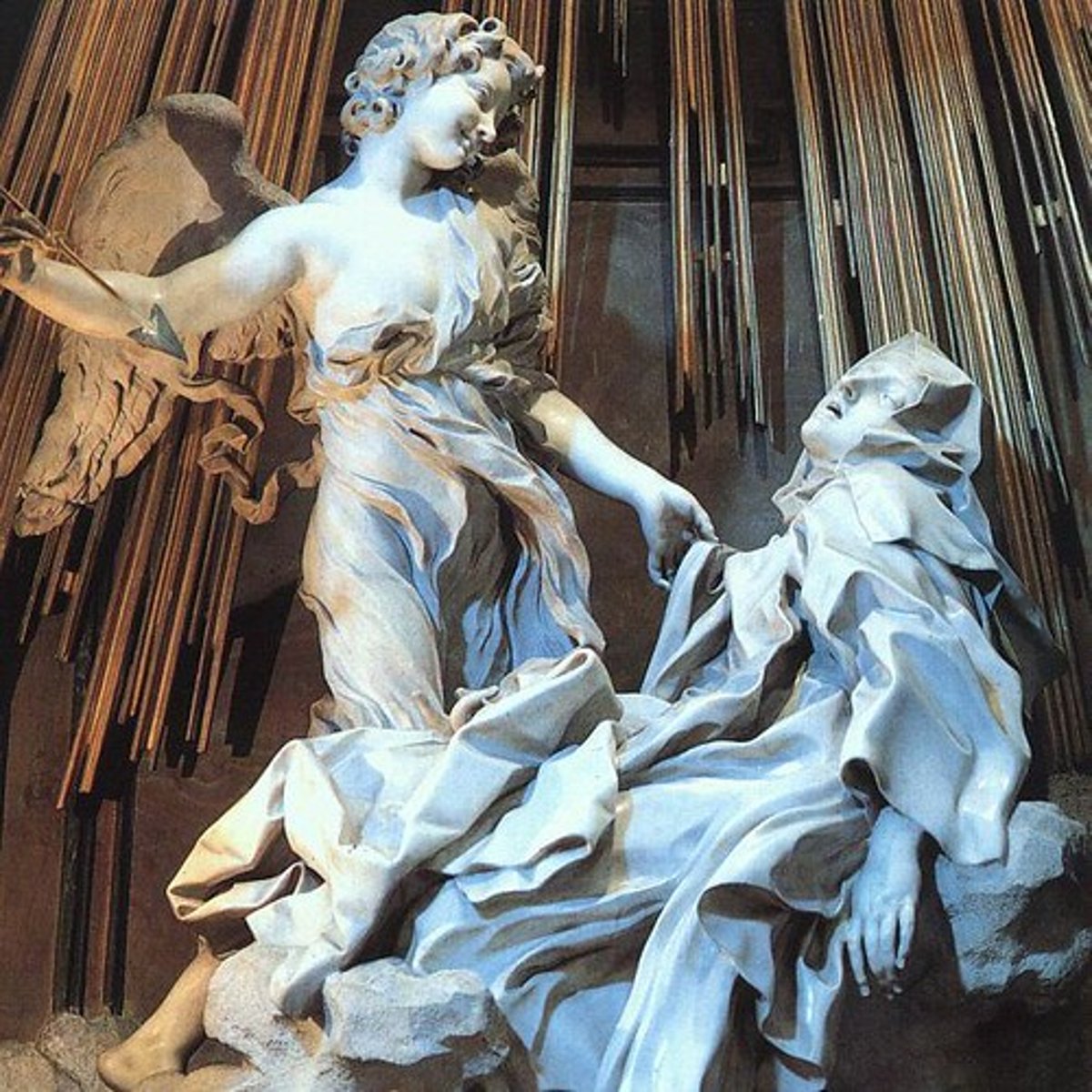
What about Borromini's design for the Church of San Carlo marks it as being "audacious"?
Instead of using modular additive system of planning, he worked from an overriding geometrical scheme for the ideal, domed, central plan church
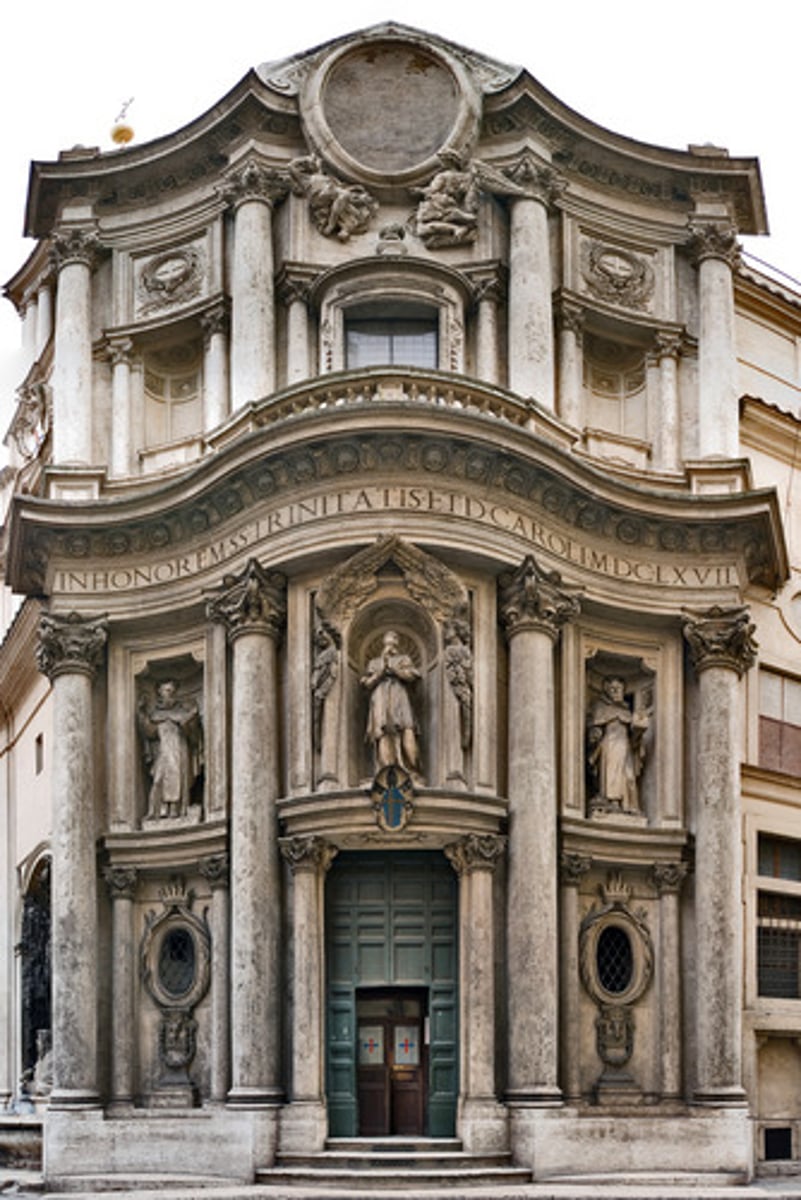
In Baroque painting and sculpture, the interplay of strong light and shadow is a major expressive element. The visual drama this interplay creates is also to be seen in Baroque architecture. What are the means whereby Borromini created this drama in the façade of the Church of San Carlo alle Quattro Fontane?
-the buildings front was a sculpture filled area with large columns and deep concave and convex niches that then created dramatic effects of light and shadow, casting deep shadows
-The Façade has a strong vertical thrust in the center by placing statue filled niche over the doorway
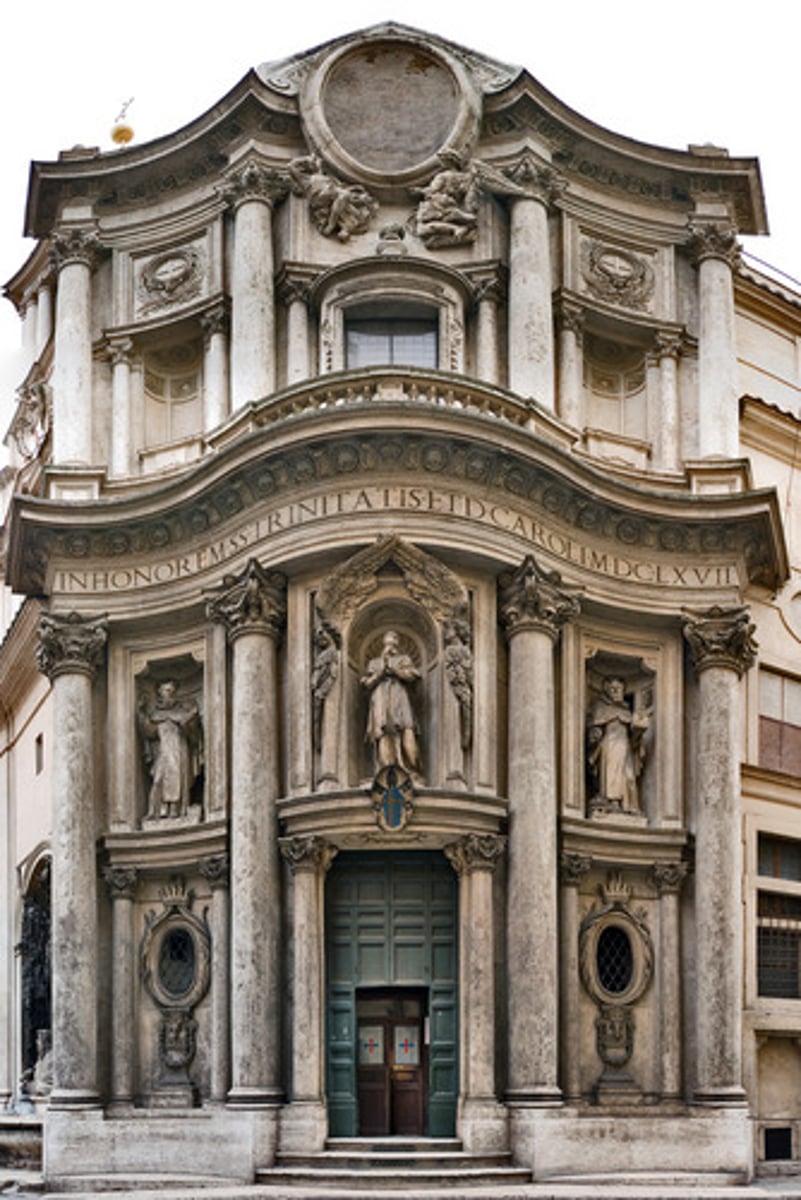
What is the literary source for the scenes on the ceiling of the gallery in the Palazzo Farnese and what is the iconography of the central scene?
The triumph of bacchus and Ariadne
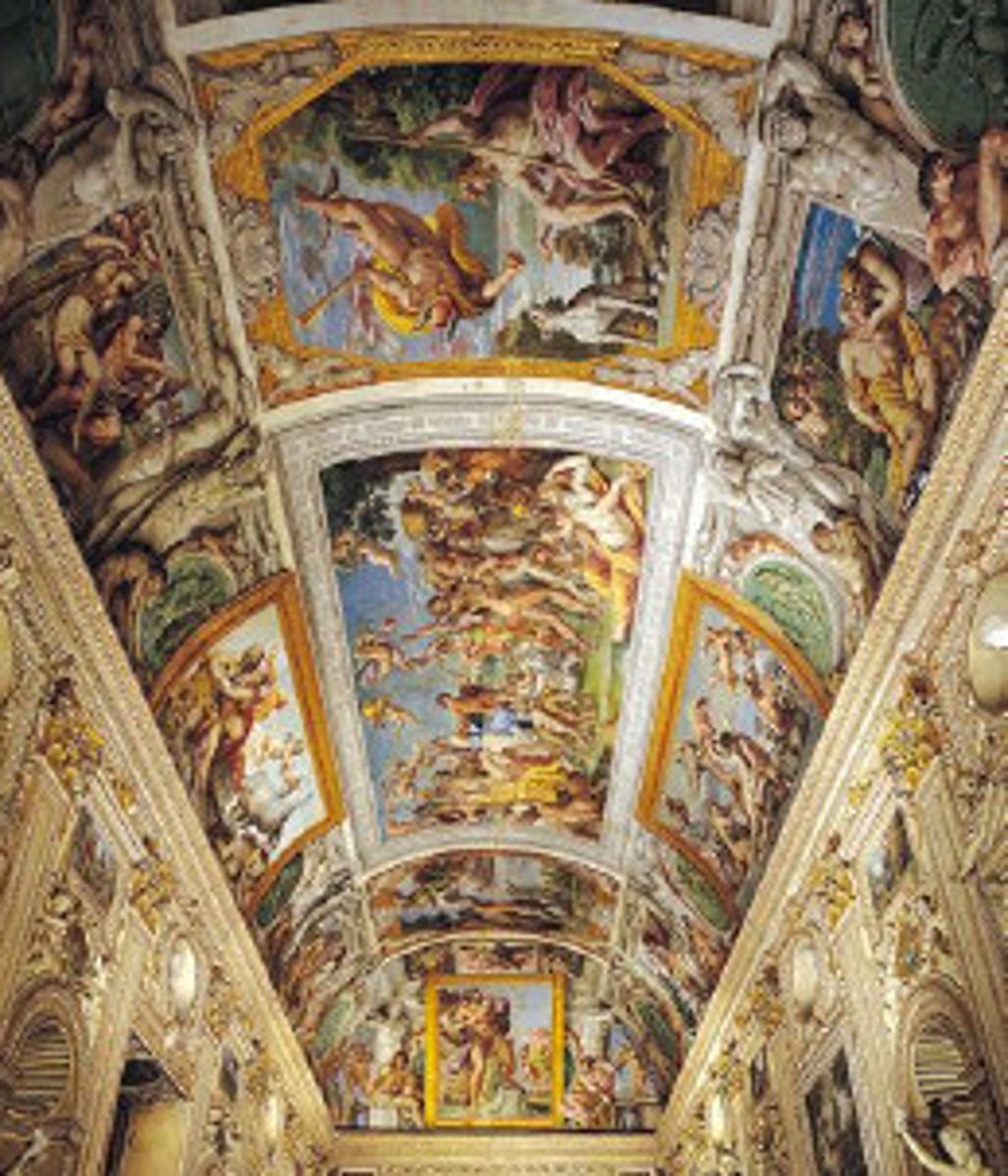
What features of the gallery ceiling of the Palazzo Farnese are derived from Michelangelo's Sistine Chapel ceiling and what features recall the work of the Venetians Titian and Veronese?
sistine chapel- figure types are heroic, muscular, and drawn with precise anatomical accuracy. numerous compartments for paintings in fresco, quadri riportati, illusionistic architecture, fictive reliefs, Atlas-like figures to "hold up" the cornices around the top of the walls.
venitians titian and veronese- the ceiling glows with warm light and seems buoyant with optimism and lively engagement. rich colors, dramatic lighting effects and the depiction of rich fabrics and textiles.
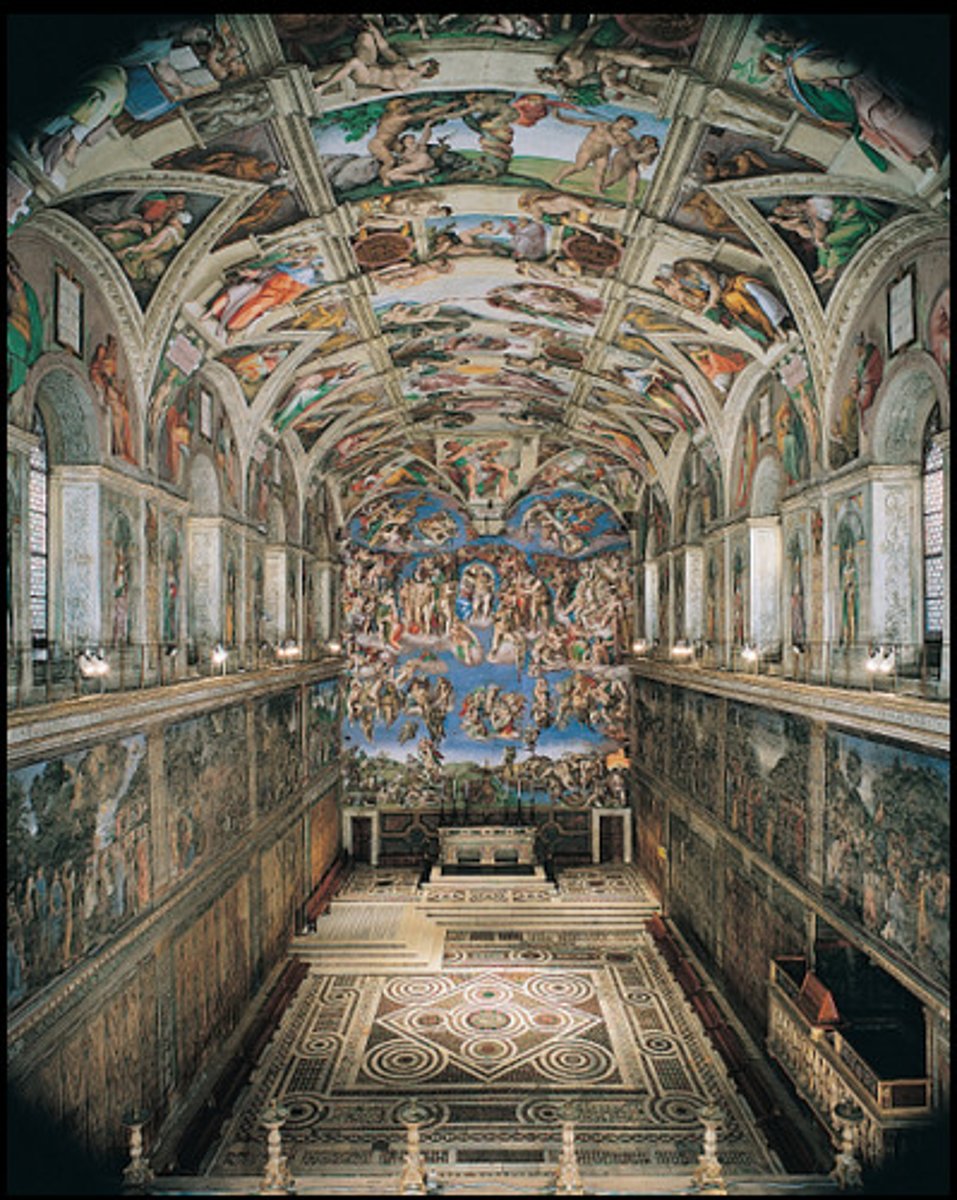
Undertake a careful study of the composition and other formal features in Caravaggio's The Calling of Saint Matthew. The figure pointing to himself is Saint Matthew (Levi).
-Natural light streams in from the left of the painting casting shadows and leading you to the focal point.
-Christ is cast in deep shadow, except for his face and halo, which is lit from the light coming in.
-An intense raking light enters the painting leading the viewers' eyes to the focal point.
-Witnessing the scene as it's occurring, elevated on a recessed opening through the wall before them
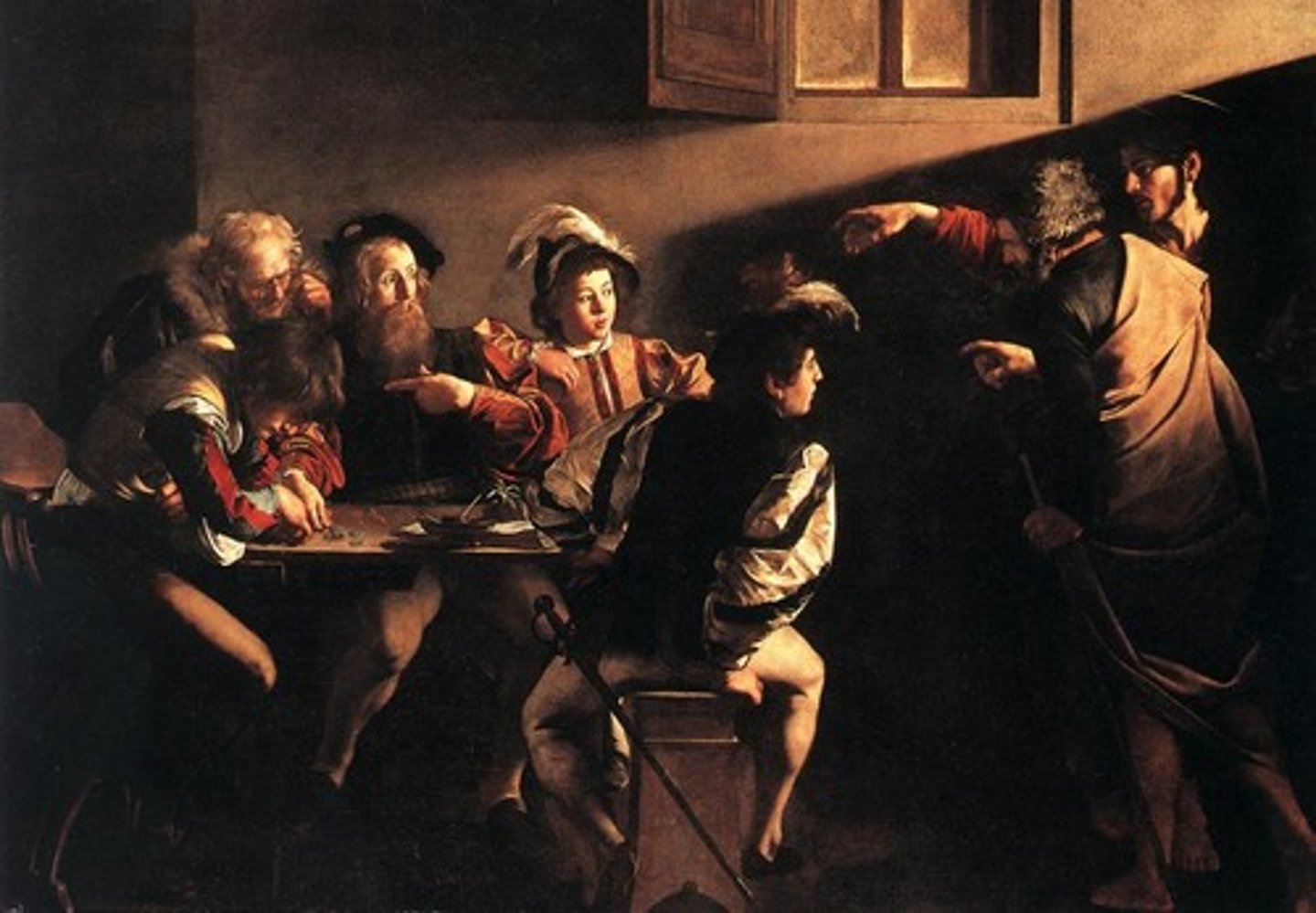
The hand of Christ in The Calling of Saint Matthew was derived from what Renaissance source?
-The Creation of Adam by Michelangelo
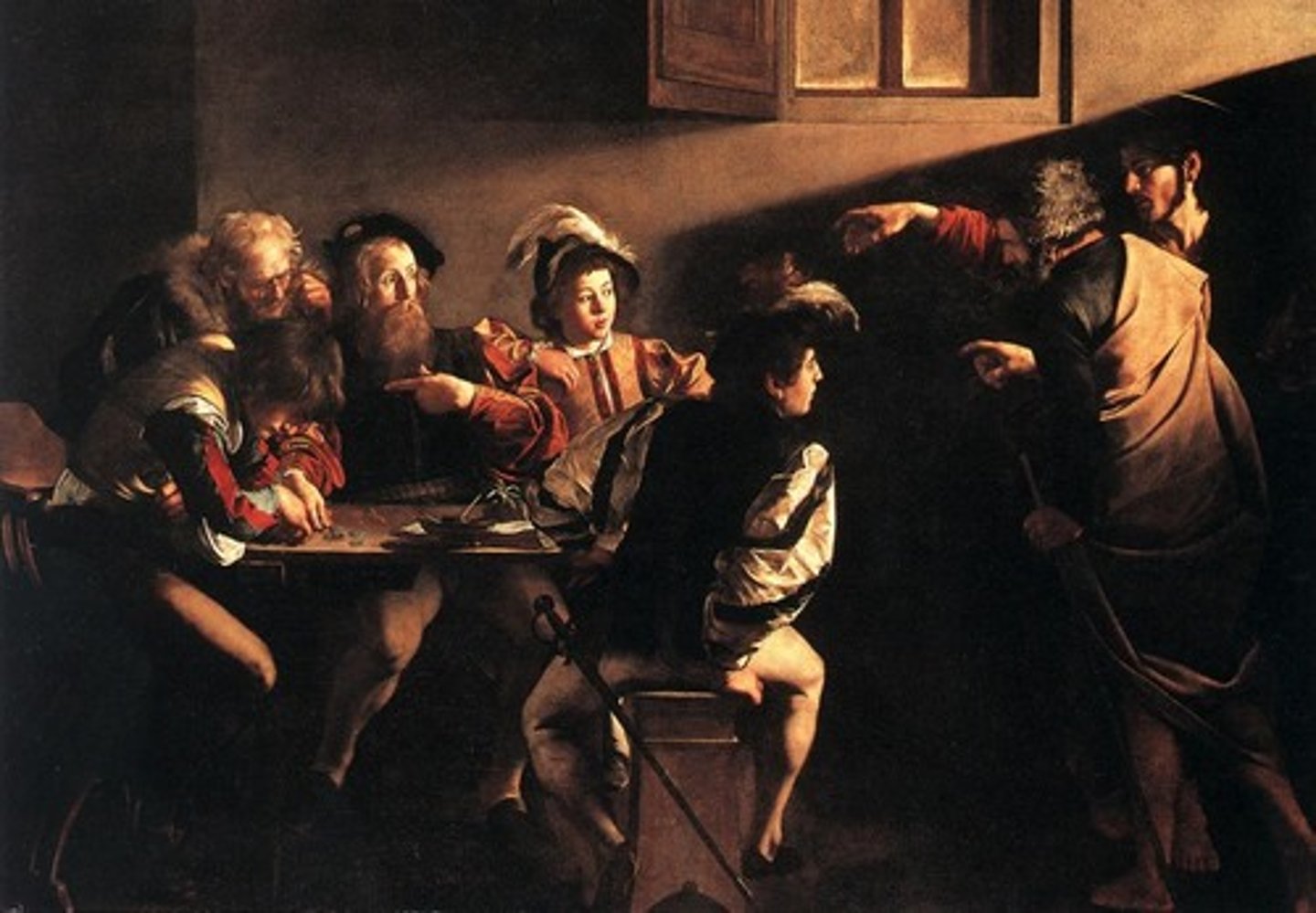
Certain aspects of the religious works by Caravaggio are comparable in what way to the preaching of the mystic Filippo Neri?
-Combining intensely observed figures, poses, and expressions with strong contrasts of light and color to to interpret his religious subjects directly and dramatically
What are the general characteristics of Caravaggio's religious paintings?
-Powerful brutal naturalism that was unsuitable to the subjects dignity
-painting with nothing but nature before him
-new dramatic lighting affects

Artemisia Gentileschi's rendering of the heroic biblical women may reflect what struggle?
Her rape and her testimony in her rapists trial
Although the subjects are very different, Saint Serapion by Francisco de Zurbáran and Still Life with Quince, Cabbage, Melon, and Cucumber by Juan Sánchez Cotán share certain formal characteristics and convey a similar mood. Explain what these have in common.
-use of extreme lights and darks. This highly artificial arrangement of strikingly lifelike forms suggests not only a fascination with spacial ambiguity but also a contemplative sensibility and interest in the qualities of objects similar to Zurbaian
- Black background with a strong emphasis on the subject matter
-Careful rhythmic space
-"Quiet" work of art
-Few colors are used.
Zurbaran's St. Serapion is a deeply moving, evocative and beautiful painting. What Baroque characteristics are the be found therein?
-evokes emotional response
-white rope greatly contrasts w/ dark shadows
-deep folds in the robe add more highlights and shadows
-limp hands add to intensity
-The dead man's pallor, his tough hands and his course ropes contrast with the off-white of this creased mecceadrian in a pattern of highlights and varying depths of shadow this timelessly immobile composition is like a tragic still life, a study of fabric and flesh became inanimate , silent and at rest.
-Drama in the fabric, the bend of head combine with the tension of arm in the air, balance by the white note in the corner.
-Dramatic positioning, strong contrast of light and dark, emotional involvement in what happened to the portrayed figure, lots of negative space, a paused moment in time.
-Chiaroscuro, tenebrism, emotional, diagonals
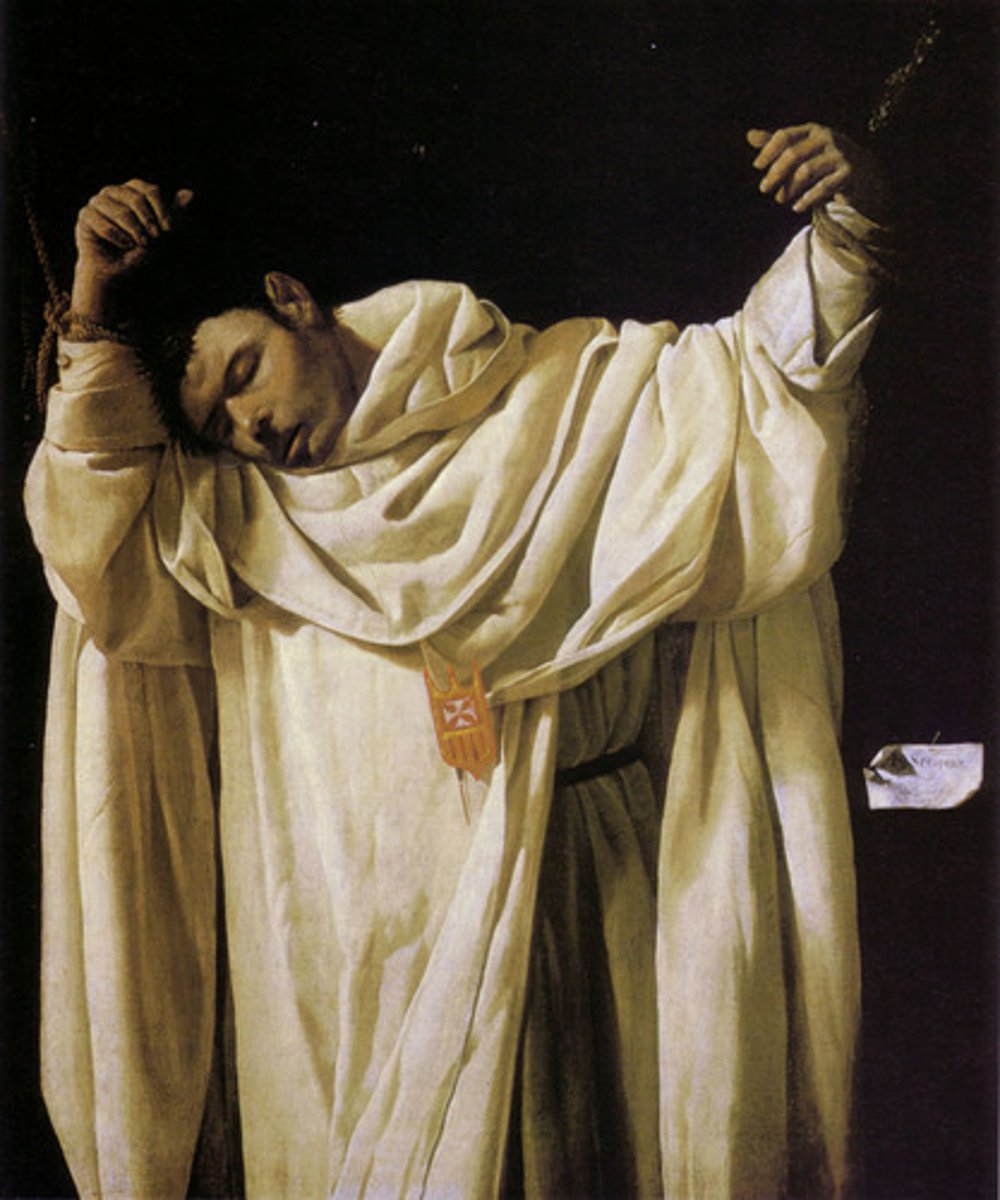
Las Meninas is one of the best known paintings of Diego Velázquez. In what way did he utilize the representation of light that was contrary to the classical manner? (Refer to the caption for the painting.)
-rather than using light to model volumes in the time-honored manner, he tried to depict the optical properties of light reflecting from surfaces (light was hitting other things, then bouncing back)
-used minimum of underdrawing (barely sketched/planned) building up his forms with layers of loosely applied paint and finishing off the surfaces with dashing highlights.
-Luminosity is achieved by laying down a thick layer of lead white
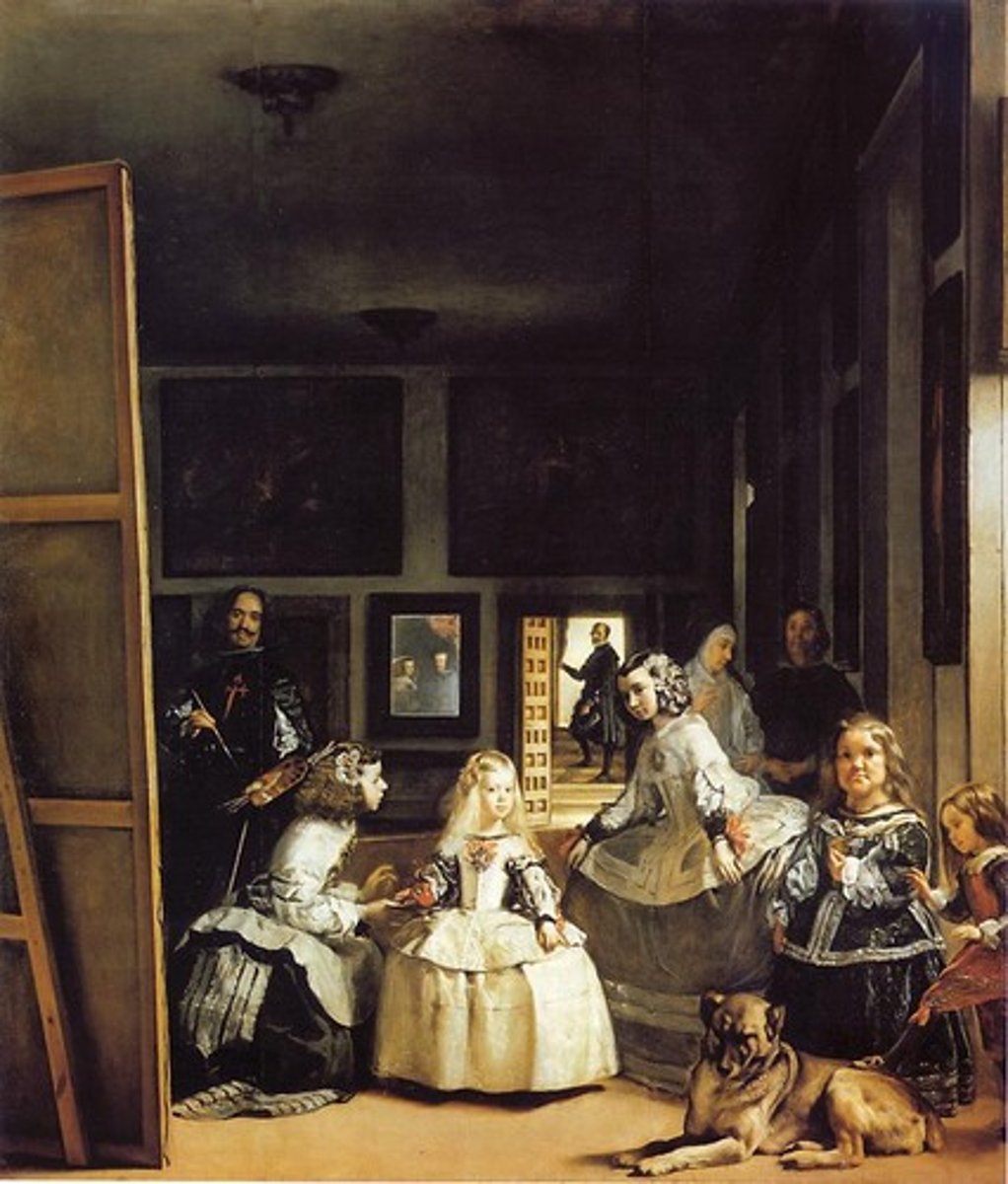
In addition to the lively brushwork, what other formal features contribute to making Las Meninas a painting that is full of vitality and one that engages the viewer in an active dialogue? (rf. to the lectures)
-draws viewers directly into the scene
-Use of dashing highlights in white, lemon yellow, and pale orange.
-eye contact, reflection in mirror, overlapping composition, good use of natural light/shadow
-Reflection of the queen and king can be seen in the back mirror.
-The expressive movement of the brushstrokes.
-Motions of people's gazes.
The painting Still Life with Flowers, Goblet, Dried Fruit, and Pretzels by Clara Peeters is a still life of what type?
Breakfast Pieces
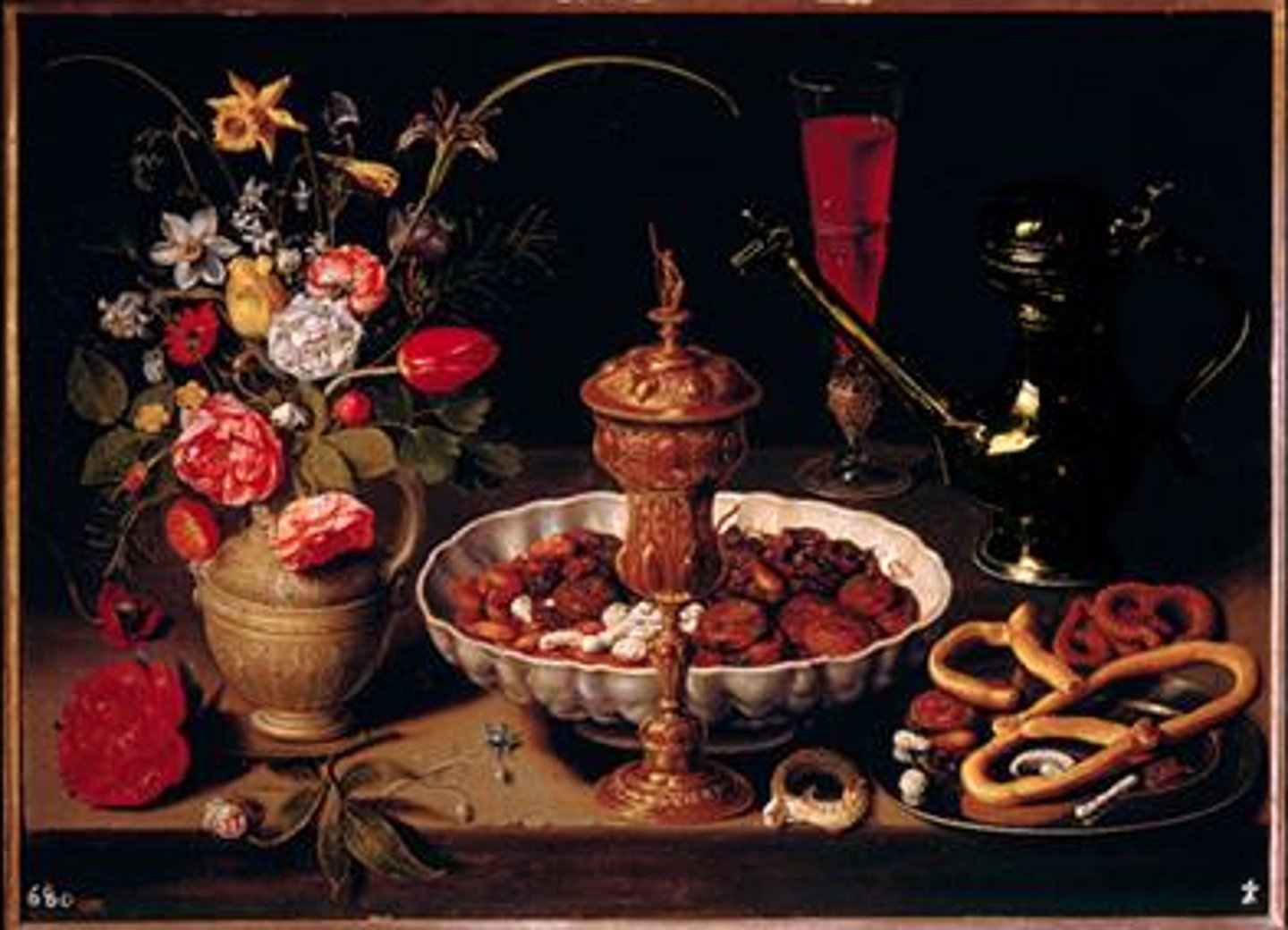
Dark, neutral backgrounds serve what function in still lifes?
-strong contrast, emphasis on how the light falls
-Allows the figures to emerge from ambience and frames their bodies and faces
The Dutch "taste for art" and "demand for art" had certain consequences for the production of art. Explain.
-Artists had to compete to capture the interests of the public by painting on speculation
-demand gave rise to an active market for the graphic arts both for original comparisons and for copies of paintings since one copper plate produce hundreds of impressions
Study the formal structure of The Night Watch. How has he unified the work psychologically? How has he composed the scene so that it is full of life and vitality?
-the work carries the idea of a group portrait as a dramatic event
-dense layer of grime had darkened and obscured its colors, but after cleaning and restoring, it now has a palette of rich colors providing a sense of exuberance
All of the figures are unified as a collective group because of their focus on this single, important, dramatic event
-arranges the figures in a way that they are reinforced by the striking use of light and shade.
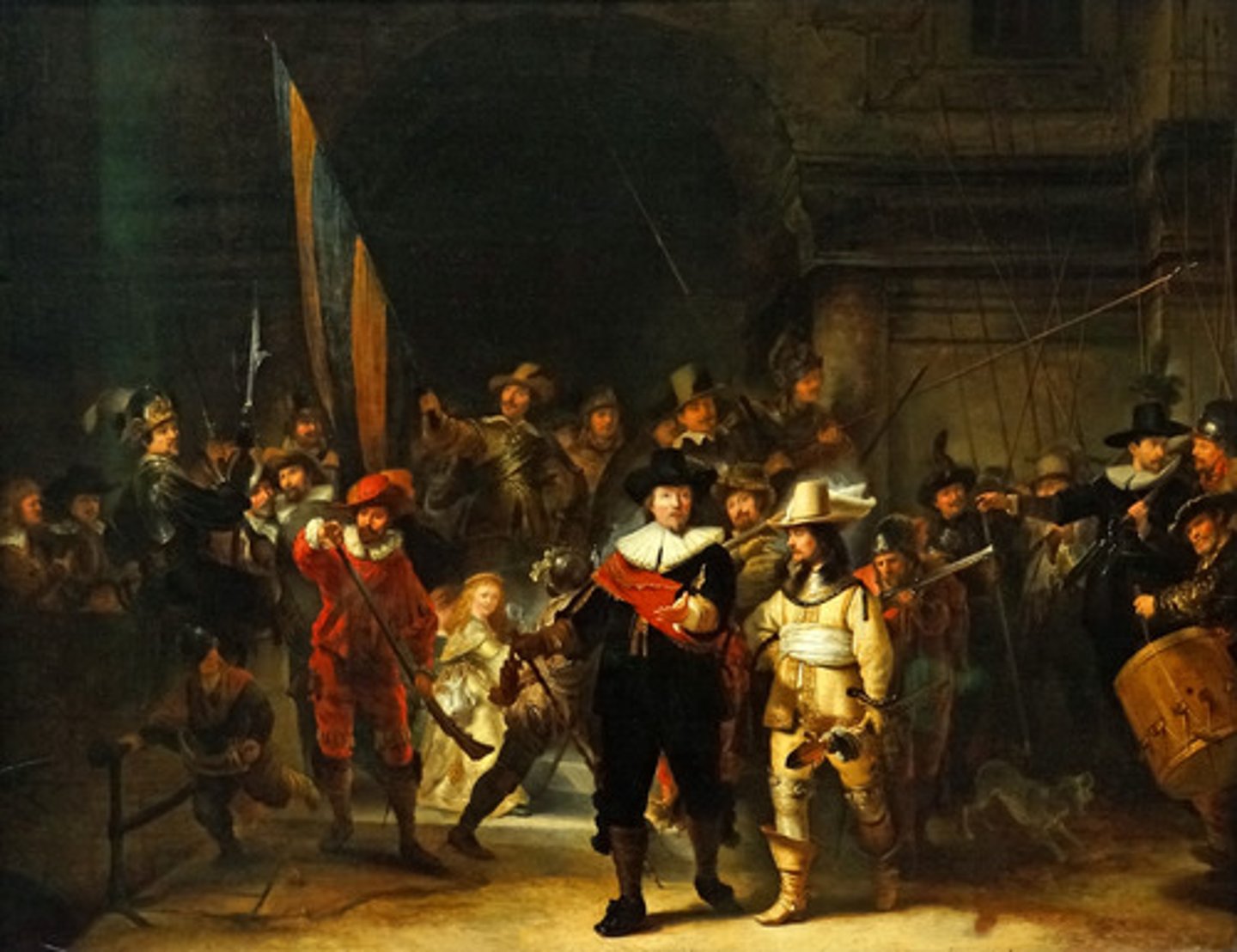
Rembrandt explored the expressive possibilities of what two printing techniques?
etching and drypoint
Study the text box "Technique: Etching and Drypoint." In what ways do the two print techniques employed by Rembrandt resemble the character of drawing?
In both techniques, the artist has to essentially "draw" out the designs/outlines which makes them very similar to drawing
In his later works, Rembrandt sought to portray profound, inner meanings of human spiritual experience. Explain how this pursuit can be exemplified in the differences between the earlier and later, fourth state of the Three Crosses. The fourth state is in MDID and will be presented in the lectures.
-Each progressive change in the work increases the focal importance of the Christ figure
-increase light & dark contrast @ each state
-Fourth state: the composition has become more compact, individual element are simplified, and the emotin are intensified.
-First stage is a rendering of a narrative moment, bustling with details; fourth stage reduces the event to it mysterious essence.
Jan Vermeer's Woman Holding a Balance may be considered a metaphor for eternal judgment and as a vanitas on what grounds?
-the women's moment of quiet introspection in front of the gold and pearls displayed on the table, shimmering with light, evokes the vanitas theme of the transcience of earthly life, allowing the painter to comment on the ephemeral quality of material things
-Eternal judgement: Her hand/scale are central, but directly behind is a painting of the Last Judgement, which highlights the figure of Christ above her head
- vanitas: The woman pondering in front of the GOLD & PEARLS, which shimmers in the light from the window shows the theme of the TRANSIENCE of earthly life
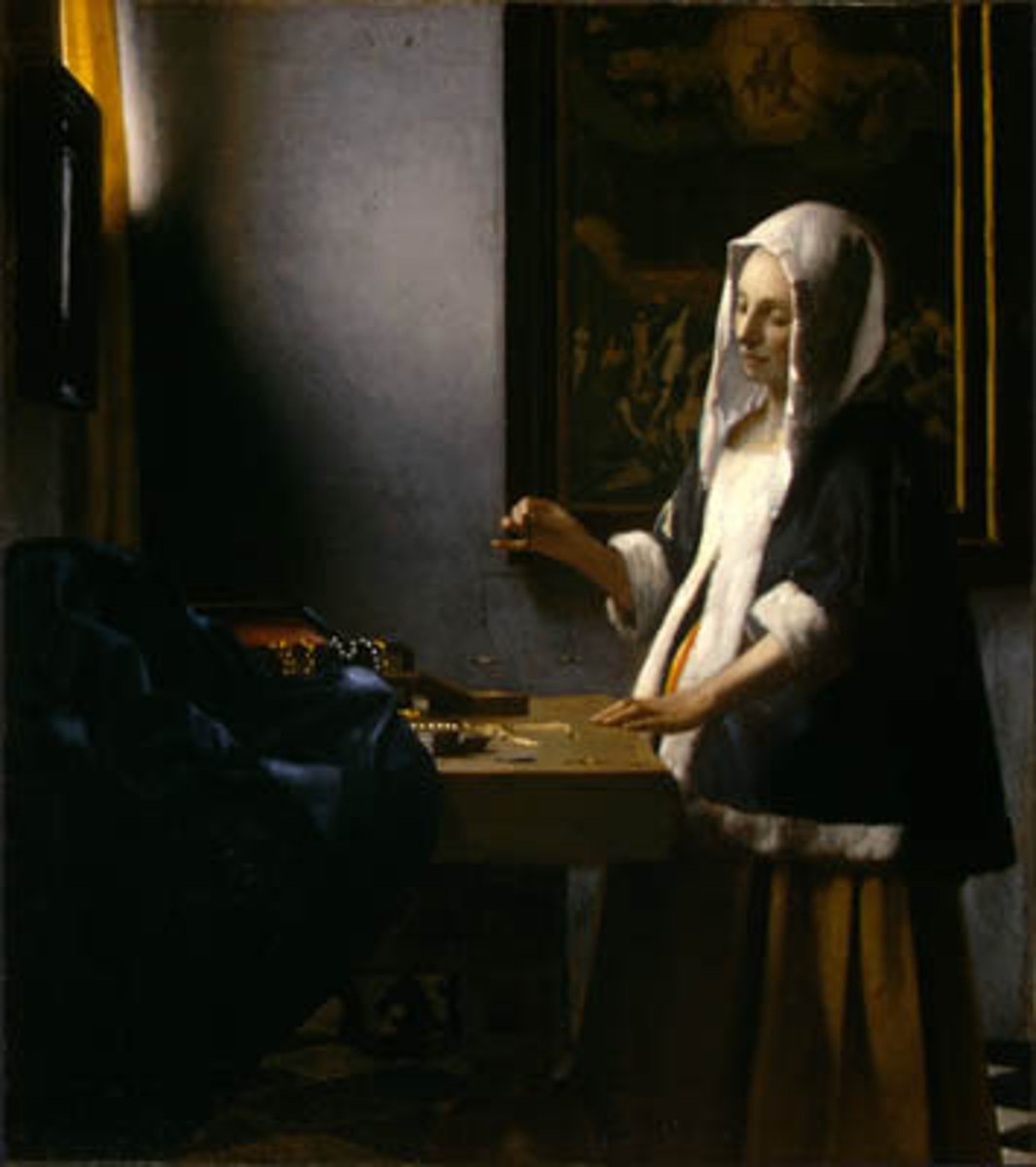
The artistic portrayal of a landscape is always an act of selection. For what purpose would the artists portray nature as different from the observed reality?
In order to give their compositions formal organization or a desired mood
By what means has Ruisdael represented the interplay of hope and transience in his Jewish Cemetery?
-The image portrayed is one of death and destruction contrasted with a rainbow and new foliage, symbolizing nature's capacity for growth and regeneration
-The decaying nature symbolizes the effects of weather and change just as people experience change and life-altering events.
-The strong elements of nature and the rainbow show that even after the rough storm the human spirit can triumph and be renewed

Still-lifes can commonly represent what moral concept? What features might represent this concept?
- transience of life and material possessions,
- skulls, which are a reminder of the certainty of death; rotten fruit, which symbolizes decay; smoke, watches, and hourglasses, which symbolize the brevity of life
Why can it be said that Dutch still-lifes are "almost never straightforward depictions of actual fresh flowers?
Artists made color sketches of fresh examples of each type of flower and studied scientifically accurate color illustrations in botanical publications.
Pause for reflection: Read for understanding the text box "Art and its Context: Science and the Changing World View." Francis Bacon and Rene Descart helped to establish what, and what distinguishes their approach to science? Read about the discoveries of Copernicus, Kepler and Gallileo. How did the Church respond to their discovery? Return to the answers to the following questions: 1 and 2 for chapter 18; 2, 3 and 16 for chapter 19; 3 for chapter 20; 2 for chapter 21; and 2 for chapter 22. Look for common threads and the interrelationship of art and culture.
-
Very carefully read the text box "Art and Its Context: Grading the Old Masters." A firm understanding of the issues that divide the rubénistes from the poussinistes is very important for this course. What are the issues?
-admirers of Poussin argued that drawing was superior to color because drawing appealed to the mind while color appeared to the senses
-admirers of Titian, Veronese, and Rubens claimed that painting should deceive the eye, and since color achieves this deception more convincingly than drawing, color should be valued over drawing
Rubenistes
- Claimed that painting should deceive the eye
- COLOR IS VALUED OVER DRAWING
Poussinistes:
- drawing appealed to the mind while color appealed to the sense
- DRAWING SUPERIOR OVER COLOR
Claude Lorrain and Nicolas Poussin represented nature in what way? The result is a style of landscape representing "Nature," designated with a capital "N" in order to differentiate it from a style representing nature "as it is," a nature indicated by using a lower case "n". (rf the lectures)
-idealized view of nature, beautiful
-they organized natural elements and figures into gently illuminated, idealized composition.

What is the true subject of Poussin's paintings?
The balance and order of nature
What is Claude Lorrain's "favorite and much imitated device"?
to place one or two large objects in the foreground past which the viewer's eye enters the scene and proceeds, often by diagonal paths, into the distance
